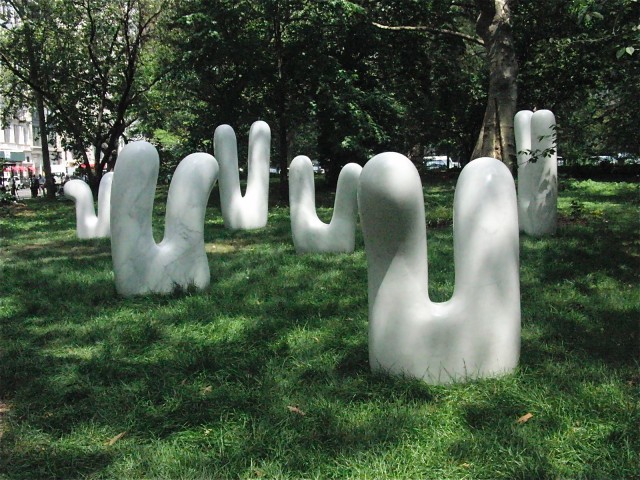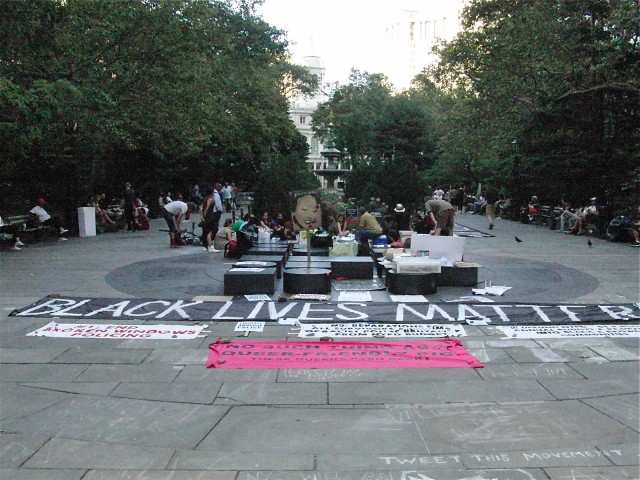
The seven sculptures that make up Claudia Comte’s “The Italian Bunnies” are named after Italian sculptors (photo by twi-ny/mdr)
City Hall Park
Broadway, Park Row, and Chambers St.
Through September 29, free
www.publicartfund.org
www.nycgovparks.org
If you find yourself walking through City Hall Park and a woman gazes into your eyes and starts singing to you and you alone, it might not be some weirdo but actually part of the Public Art Fund group exhibition “The Language of Things.” The show was inspired by Walter Benjamin’s 1916 essay “On Language as Such and on the Language of Man,” in which the German philosopher and critical theorist explores “the difference between human language and the language of things.” He writes, “Every expression of human mental life can be understood as a kind of language, and this understanding, in the manner of a true method, everywhere raises new questions. It is possible to talk about a language of music and of sculpture, about a language of justice . . . all communication of the contents of the mind is language, communication in words being only a particular case of human language and of the justice, poetry, or whatever underlying it or founded on it.” The multiple works in this exhibition vary wildly in conception and execution, but they all communicate. The only work that features spoken human language is the above-mentioned Tino Sehgal piece “This You,” the artist’s first outdoor work, in which one of a rotating cast of women singers approach strangers and warble something meant specifically for them. Chris Watson’s four-channel “Ring Angels” is named for the suspicious concentric patterns that appeared on British radar in the 1930s, which turned out to be roosting starlings; Watson’s audio piece plays the sounds of modern-day starlings moving in close formation while referencing the arrival of starlings to America in 1890–91, when Eugene Schieffelin released first sixty and then forty starlings into Central Park in an effort to introduce to North America all the avian species mentioned in Shakespeare.

The Black Lives Matter movement brought its message to Adam Pendleton’s “Untitled (code poem)” in City Hall Park (photo by twi-ny/mdr)
In Claudia Comte’s “The Italian Bunnies,” seven marble sculptures resembling bunny ears, and named for Italian artists (Guido, Pietro, Gian Lorenzo, Leonardo, Donatello, Michelangelo, and Properzia), appear to be in the midst of a silent conversation. Carol Bove’s “Lingam” refers to ancient Hindu phallic sculptures dedicated to Shiva and brings together petrified wood and steel as if they are engaged in some kind of symbolic ritual. Michael Dean’s reinforced concrete “4sho (Working Title)” developed from his own texts and typography. Don’t spend too much time trying to figure out how Hannah Weiner’s “Code Poems” work; in 1969, the poet and performance artist wrote, “i consider this code an exploration of linear communication, which has served the binary neurological function of the brain. the most useful thing for me here, in the code, is the understanding of the equivalents: one kind of signal may equally be substituted for another with the exact same meaning.” Directly influenced by Weiner’s work, Adam Pendleton’s “Untitled (code poem)” consists of eighteen concrete blocks in the shape of large-scale Morse code dots and dashes; for several days, people from the Black Lives Matter movement took over the space, using the blocks as seats as they spread their oft-misunderstood message, giving the piece an unexpected twist on the idea of communication. “The linguistic being of things is their language; this proposition, applied to man, means: the linguistic being of man is his language. Which signifies: man communicates his own mental being in his language,” Benjamin further explains. “It should not be accepted that we know of no languages other than that of man, for this is untrue.”